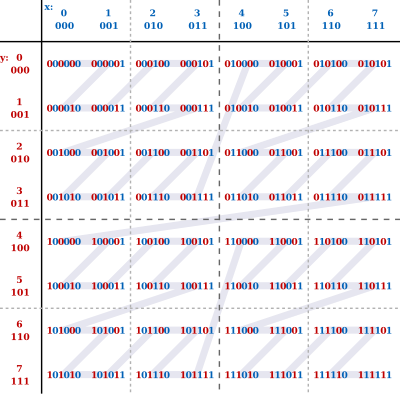z-order curve (a.k.a. Morton order) implementation in Python
Project description
pyzorder
Python implementation of z-order curve (a.k.a. Morton order)
z-order curve maps multidimensional data to one dimension.
Using z-order curve, you can implement multidimensional sort key for DynamoDB, which allows only 1 sort key at once. pyzorder helps to implement ranging indexing with z-order curved data.
(日本語ドキュメントは、英語版の後ろにあります)
What is "z-order curve"?
"z-order curve" maps multidimensional data to one dimension while preserving locality of the data points. The z value is calculated by interleaving input values.

Typical usage is for DynamoDB, which allows only 1 sort key at once. For example, if you want to indexing the data with both x-axis and y-axis, you can map x and y with z-order curve, and put the z-ordered data in the DynamoDB table as Sort Key. However, you have to care about "unnecessary region."
(cited again from Z-order curve - Wikipedia)
If you want to access (x = 2, ..., 3, y = 2, ..., 6), the corresponding region is dotted lines square. When accessing z-order curve sequentially, the next value of "15" should be "36". The region "16" to "35" is "unnecessary region." So, you need to treat with such "unnecessary region" efficiently.
pyzorder implements next_zorder_index which returns next valid z-order value
You can easily implement regional indexing access with z-order curved data.
next_zorder_index is re-implementaion of Tropf, H.; Herzog, H. (1981), "Multidimensional Range Search in Dynamically Balanced Trees" in Python.
next_zorder_index is shown as BIGMIN in the paper.
Usage
from pyzorder import ZOrderIndexer
zi = ZOrderIndexer((2, 3), (2, 6))
z_2_2 = zi.zindex(2, 2)
# z_2_2 = 12
zi.next_zorder_index(z_2_2)
# return 13
zi.next_zorder_index(15)
# return 36
Reference
- trevorprater/pymorton: A lightweight and efficient Python Morton encoder with support for geo-hashing
- Z-order curve - Wikipedia
- Z-Order Indexing for Multifaceted Queries in Amazon DynamoDB: Part 1 | AWS Database Blog
- Z-order indexing for multifaceted queries in Amazon DynamoDB: Part 2 | AWS Database Blog
- Tropf, H.; Herzog, H. (1981), "Multidimensional Range Search in Dynamically Balanced Trees"
pyzorder(日本語ドキュメント)
z-order curve (a.k.a. Morton order) の Python 実装
z-order curve は多次元データを 1 次元に集約します。
pyzorder を使うことで、DynamoDB のようなソートキーを 1 つだけ持てる DB について、多次元の領域インデックスを可能にします。
"z-order curve" とは?
z-order curve は、多次元のデータを1次元で表すための手法です。 このとき、x1 < x2 なら zorder2(x1, y) < zorder2(x2, y) という関係が常に保たれるような変換になっています。 他の次元についても同様です。
z-order curve では、各ビットをインターリーブすることで、そのようなマッピングを実現しています。
(cited from Z-order curve - Wikipedia)
利用用途として、DynamoDB のようにソート用インデックスを 1 つだけ持てるようなデータベースに対して、 複数のカラムでのインデックスを実現したい場合に使えます。 例えば、x 座標, y 座標の両方でインデックスをしたい場合などです。 z-order curve でインターリーブした値を格納しておき、その値をソートキーにすれば、2次元データに対するインデックスが可能になります。 ただし、このとき 1 つ注意すべき点があります。
(cited again from Z-order curve - Wikipedia)
(x = 2, ..., 3, y = 2, ..., 6) の範囲をアクセスしたい場合、この図では点線で囲まれた領域が該当します。 このとき、z-order の値を順番にたどると z-order "15" の次に範囲内となる z-order は "36" となっています。 つまり、このような 2 次元領域へアクセスする場合は、単純に z-order の値をたどるのではなく、このような "飛び地" を効率よく処理する必要があります。
pyzorder は、"15" の次の有効な z-order である "36" を求める next_zorder_index を実装しています。
これにより、z-order curve で表現されたデータから、任意の2次元領域へのアクセスを実現できます。
なお、next_zorder_index を求めるアルゴリズムは Tropf, H.; Herzog, H. (1981), "Multidimensional Range Search in Dynamically Balanced Trees"
で提案されたものを Python で実装することで実現しています。(論文中の BIGMIN という関数が該当します)
使い方
from pyzorder import ZOrderIndexer
zi = ZOrderIndexer((2, 3), (2, 6))
z_2_2 = zi.zindex(2, 2)
# z_2_2 = 12
zi.next_zorder_index(z_2_2)
# return 13
zi.next_zorder_index(15)
# return 36
参考
- trevorprater/pymorton: A lightweight and efficient Python Morton encoder with support for geo-hashing
- Tropf, H.; Herzog, H. (1981), "Multidimensional Range Search in Dynamically Balanced Trees"
- Z-order curve - Wikipedia
- Z-Order Indexing for Multifaceted Queries in Amazon DynamoDB: Part 1 | AWS Database Blog
- Z-order indexing for multifaceted queries in Amazon DynamoDB: Part 2 | AWS Database Blog
Project details
Release history Release notifications | RSS feed
Download files
Download the file for your platform. If you're not sure which to choose, learn more about installing packages.












